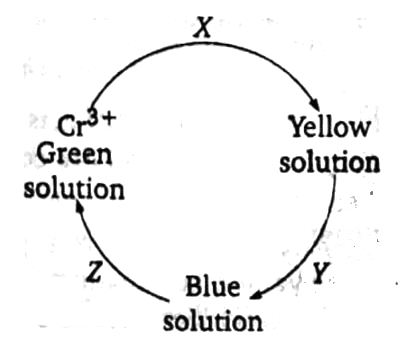B2H6+NH3→Addition compound (X) 450K−−→ Y+Z(g)
In the above sequence Y and Z are respectively :
Borazine and hydrogen
Boron and hydrogen
Boron nitride and hydrogen
Borazine and hydrogen
The correct Answer is:D
To solve the problem, we need to analyze the reaction between diborane (B₂H₆) and ammonia (NH₃) and identify the products formed after heating.
1. Identify the Reactants:
- The reactants in the reaction are diborane (B₂H₆) and ammonia (NH₃).
2. Formation of the Addition Compound (X):
- When diborane reacts with ammonia, they form an addition compound. The reaction can be represented as:
B2H6+2NH3→B2H6⋅2NH3
- This compound is called an adduct and is denoted as (X).
3. Heating the Addition Compound:
- When the addition compound (X) is heated at 450 K, it undergoes decomposition. The reaction can be represented as:
2B2H6⋅2NH3450K−−−→B3N3H6+3H2
- Here, B₃N₃H₆ is formed along with hydrogen gas (H₂).
4. Identify the Products (Y and Z):
- From the decomposition reaction:
- Y is B₃N₃H₆ (borazine).
- Z is H₂ (hydrogen gas).
5. Final Answer:
- Therefore, the products Y and Z are:
- Y = B₃N₃H₆ (borazine)
- Z = H₂ (hydrogen gas)
Conclusion:
The correct answer is:
- Y = Borazine (B₃N₃H₆)
- Z = Hydrogen gas (H₂)
- The reactants in the reaction are diborane (B₂H₆) and ammonia (NH₃).
- When diborane reacts with ammonia, they form an addition compound. The reaction can be represented as:
B2H6+2NH3→B2H6⋅2NH3
- This compound is called an adduct and is denoted as (X).
- When the addition compound (X) is heated at 450 K, it undergoes decomposition. The reaction can be represented as:
2B2H6⋅2NH3450K−−−→B3N3H6+3H2
- Here, B₃N₃H₆ is formed along with hydrogen gas (H₂).
- From the decomposition reaction:
- Y is B₃N₃H₆ (borazine).
- Z is H₂ (hydrogen gas).
- Therefore, the products Y and Z are:
- Y = B₃N₃H₆ (borazine)
- Z = H₂ (hydrogen gas)
The correct answer is:
- Y = Borazine (B₃N₃H₆)
- Z = Hydrogen gas (H₂)
Topper's Solved these Questions
Similar Questions
In this sequence X, Y , Z are respectively:

View Solution4AgNO3+2Cl2dry→4X+2Y+Z
In the above sequence of reaction y and z are respectively.
View SolutionN2+H2→[X](g)CO2,Pressure−−−−−−−→[Y]Heat−−→[Z]+H2O In the above sequence of reaction, [Y] and [Z] are respectively.
View SolutionIsopropylamine KMnO4−−−−→XH+3O−−→Y
In the above sequence X and Y are
View SolutionSilver cyanide Δ−−→Silver+AOH−−−→X+Y+H2O In the above sequence of reaction A,X,Y are respectively.
View SolutionSO2(g)+Cl2(g)→XP4−−→Y+Z
then X, Y and Z can be :
View SolutionCl2(g)+Ba(OH)2→X(aq.)+BaCl2+H2O
X+H2SO4→Y+BaSO4
YΔZΔ>365K+H2O+O2
Y and Z are respectively:
View SolutionCl2(g)+Ba(OH)2→X(aq.)+BaCl2+H2O
X+H2SO4→Y+BaSO4
YΔZΔ>365K+H2O+O2
Y and Z are respectively:
View SolutionStarch X−−→ Maltose Y−−→ Glu cose Z−−→ Ethyl alcohol , X, Y, Z in the above sequence are :
View SolutionA compound contains three elements X, Y and Z. The oxidation number of X, Y and Z are +3,+5and−2 respectively. The possible formula of the compound is
View Solution
